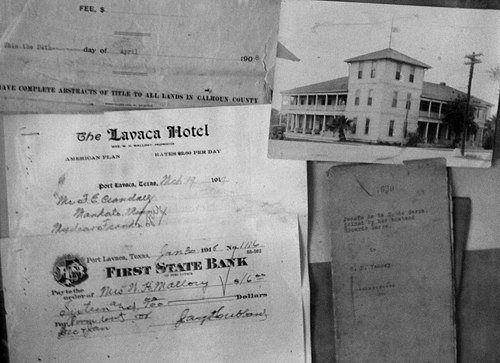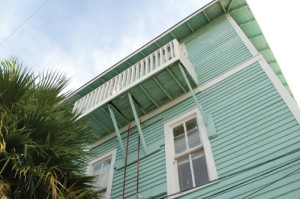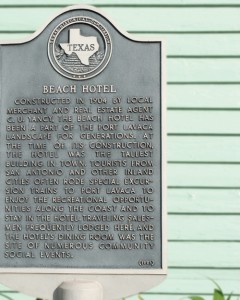We are all creatures of habit; travelling to and from work, school and many habitual locations until something or someone ignites a spark of interest in a subject we are unfamiliar with. I don’t know about you, but I always want to find out what the scoop is. This all came about as it always does, a simple conversation with a friend about historical markers. And as always, I was intrigued. It instantly took me back to one of the first times I strolled down Main Street in Port Lavaca, camera in hand — it had been a while so I felt the need to return.
As I pulled up and parked alongside the turquoise building, it loomed before me. The sea breeze was fresh as rain. In tune with the new trend, it had fallen not more than an hour ago, the air remained crisp and the gravel churned beneath my feet. I drive by this particular building at least once a day. It has peaked my interest before; I’m glad I finally stopped to peer inside the Seascape Apartments.
Once upon a time the apartment home was a hotel with approximately thirty-three rooms, now it houses nine apartments and a furniture store. At one point, it was a restaurant.
The hotel, once known as the Beach Hotel , is one of forty-five historical markers located in Calhoun County.Historical marker #345 reads as follows: Constructed in 1904 by local merchant and real estate agent C. U. Yancy, the Beach Hotel has been a part of the Port Lavaca landscape for generations. At the time of its construction, the hotel was the tallest building in town. Tourists from San Antonio and other inland cities often rode special excursion trains to Port Lavaca to enjoy the recreational opportunities along the coast and to stay in the hotel. Traveling salesmen frequently lodged here, and the hotel’s dining room was the site of numerous community social events. (1991)
No wonder the building seemed to encompass the corner appropriately, positioned at the corner of Main and Commerce Street, it is a busy intersection. Not only today, but back in its heyday as well. The railroad, Southern Pacific Lines, offered weekend excursions to Port Lavaca from San Antonio until the 1930s. Southern Pacific bought the San Antonio & Mexican Gulf Railroad in 1884. Chartered in 1850, the San Antonio & Mexican Gulf Railroad was one of the first railroads in Texas.
As I entered into the hotel, I could already envision how popular it was in the early 1900s. The hotel had a certain energy surrounding it, I walked through the first floor hallway, I stopped and peered upstairs from the beginning of the staircase, my imagination soaring.
I reached the end of the hallway which lead towards an exit to the bay front. Following the signs I walked to the building next door, Davila’s Repair Shop. There I found Alex Davila. He explained the building had gone trough several reincarnations, and is currently owned by his father, Ray Davila. Ray purchased the hotel on July 20, 1978 from the Bauer’s. At the time they lived in Brookhollow Estates on Seascape Drive. As a symbolic gesture, he and wife, Tina, renamed the hotel Seascape Apartments. Isn’t that something? Thirty-four years ago, almost to the exact date and as Alex said, “It seems like a week ago.”
The Davila’s have records from as far back at 1904 documenting the building’s origin. As I glanced over the historical documents I saw a receipt which stated rates in 1910 were $2.00 a day, even a $16.00 check from the First State Bank of Port Lavaca for a week’s stay. As I chatted with Alex I learned much about what was once known as the Beach Hotel. The building has withstood the test of time including Hurricane Carla in 1961.
As the afternoon grew later I was eager to learn more about the famous politicians that stayed in the hotel in the early 1900s. With promise to return that week, I left feeling like Nancy Drew on a mission to learn more about the landmarks I cross each day. With an approximate count of thirty historical markers in Port Lavaca I knew I’d unearthed a honey pot. Till next time!

A photograph taken on the opening of Port Lavaca’s wooden causeway on July 14, 1944 with the Beach Hotel in the background.



